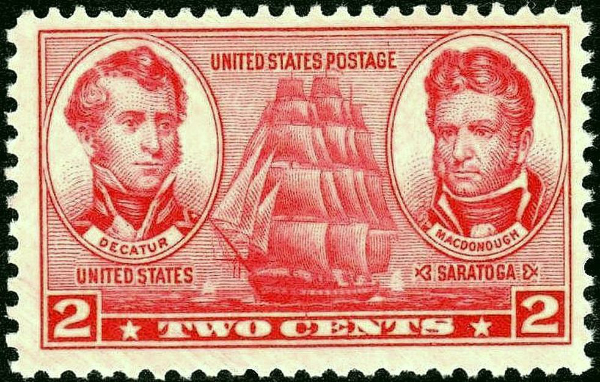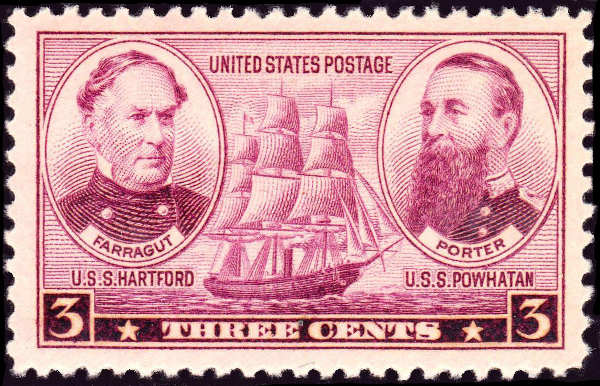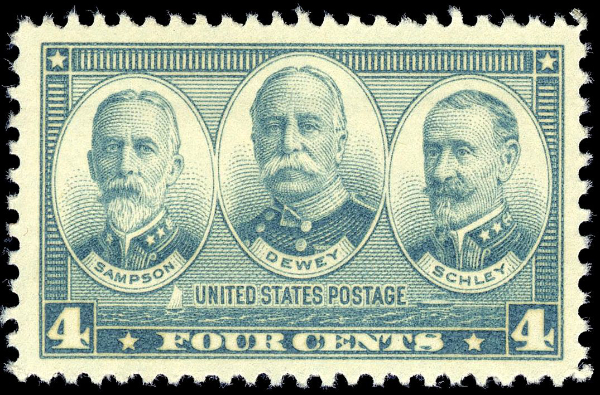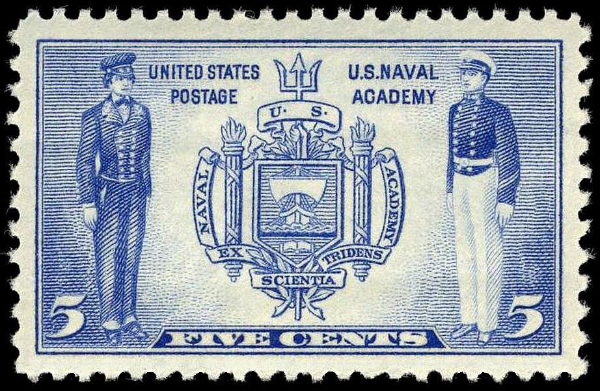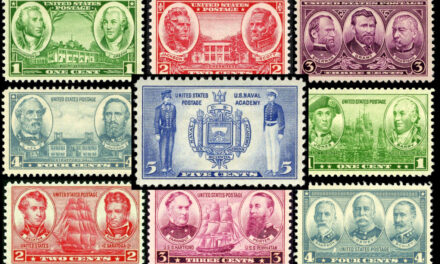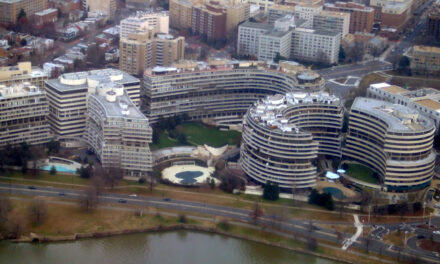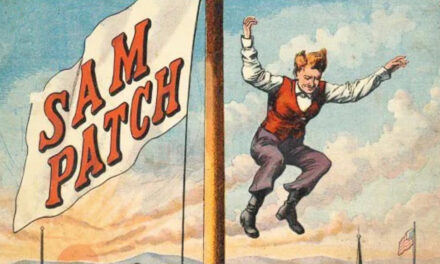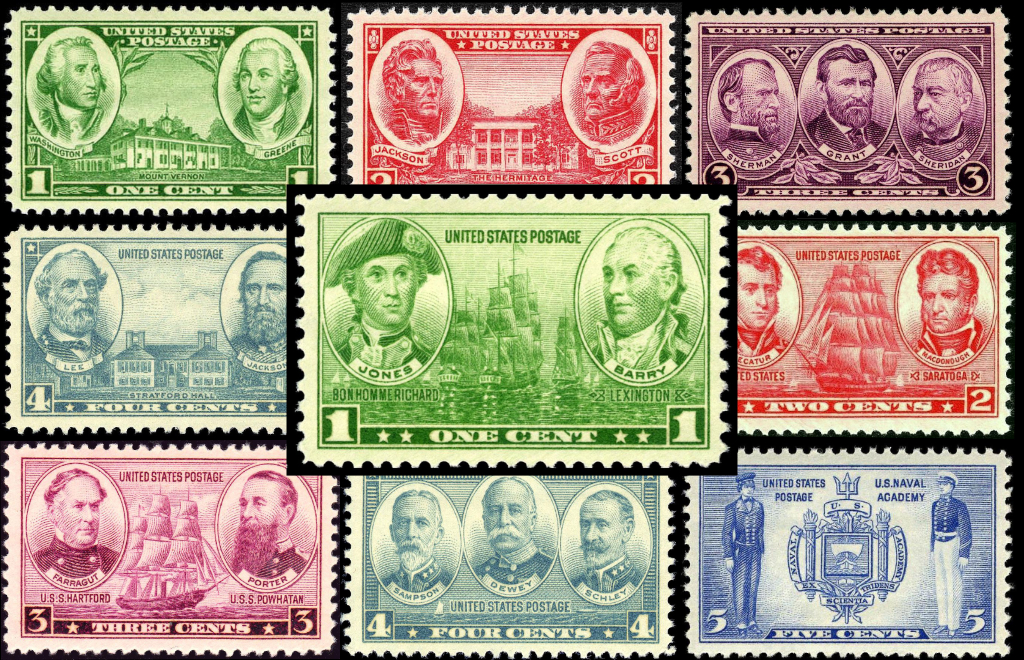
1-Cent 1936 Navy Stamp: John Paul Jones and John Barry
Revolutionary War naval heroes John Paul Jones and John Barry were honored on the one-cent Navy commemorative stamp issued by the United States Post Office in 1936. Under a portrait of each man is the name of a famous ship that he commanded: Jones’s ship the Bonhomme Richard and Barry’s brigantine the Lexington, respectively. The stamp also depicts three other vessels of the Continental Navy.
The stamp is the first in a series of five stamps that were issued between December 1936 and May 1937 to commemorate some of the most important 18th- and 19th-century naval officers in American history. A corresponding series of Army commemoratives, including the 1-cent Army stamp featuring George Washington, Nathanael Greene, and Mount Vernon, was issued on the same dates as the Navy stamps.
The Design and Issuance of the 1-Cent 1936 Navy Stamp
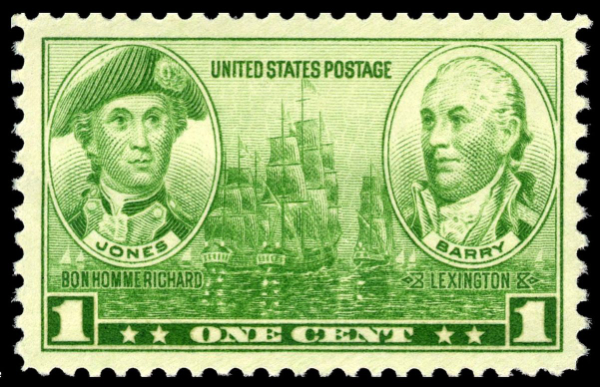
The 1-cent 1936 Navy stamp features naval heroes John Paul Jones and John Barry, along with ships of the Continental Navy. (U.S. Post Office — U.S. Bureau of Engraving and Printing, Public domain, via Wikimedia Commons)
The Other Stamps in the 1936–1937 Navy Series
Captain John Paul Jones (1747–1792)
Born in Scotland, John Paul Jones (born John Paul—he added the surname “Jones” later) sailed on various British merchant and slave ships beginning at age 13. He settled in Virginia in the early 1770s and volunteered for the Continental Navy after the outbreak of the Revolutionary War.

Portrait of Captain John Paul Jones by George Bagby Matthews, c. 1890, based on a work by Charles Wilson Peale, c. 1781. (Public domain, via Wikimedia Commons)
Raising the Flag on the Alfred
In December 1775 Jones was commissioned as a First Lieutenant and assigned to the Alfred. In early 1776, he became the first officer to raise an American flag—the Continental Colors, also known as the Grand Union Flag—over a naval vessel.
Commanding the Ranger
As the commander of the Ranger in February 1778, Jones marked another first, as the Ranger became the first American ship to be saluted by the French after France recognized the new American republic in the Treaty of Alliance. Under Jones, the Ranger won a significant battle in April 1778, capturing the British sloop HMS Drake. This victory showed that the Royal Navy was not invincible and greatly boosted American morale.
The Bonhomme Richard: “I have not yet begun to fight!”
In 1779, Jones took command of the Bonhomme Richard, which was on loan from the French to the Continental Navy. Leading a five-ship squadron, including the Alliance, Jones sailed around the British Isles and captured sixteen British merchant vessels.
On September 23, 1779, Jones engaged the British frigate HMS Serapis and a second ship, the Countess of Scarborough, in the Battle of Flamborough Head in the North Sea off the coast of Yorkshire. Although the Bonhomme Richard was badly damaged and ultimately allowed to sink, Jones rallied his crew with the vow, “I have not yet begun to fight!” and succeeded in capturing both the Serapis and the Scarborough.

Continental Navy frigates Bonhomme Richard and Alliance vs HMS Serapis, 23 September 1779. Watercolor drawing by Irwin John Bevan. (The Mariners’ Museum, Newport News, Virginia, Public domain, via Wikimedia Commons)
Service in the Imperial Russian Navy
After the war, Jones served for a time in the Imperial Russian Navy, although he remained an American citizen and naval officer. He died and was buried in Paris in 1792, but his body was brought back to the United States in the early 1900s and re-interred in the Naval Academy Chapel in Annapolis.
Commodore John Barry (1745–1803)
John Barry was an Irish Catholic merchant seaman who settled in Philadelphia in the early 1760s and built an excellent reputation for seamanship. When Barry volunteered for service in the Continental Navy in December 1775, he was commissioned as a Captain.
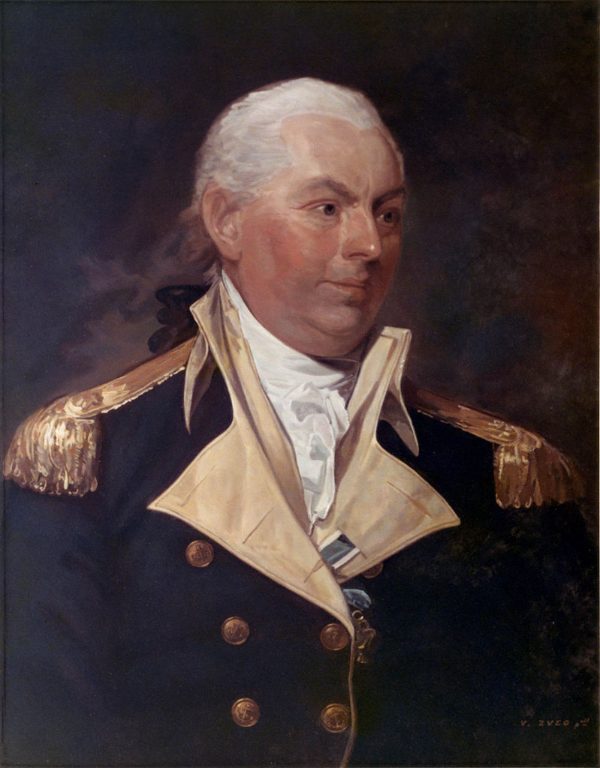
Portrait of Commodore John Barry, US Navy, by V. Zveg, 1972, from the 1801 portrait by Gilbert Stuart. (U.S. Naval Historical Center, Public domain, via Wikimedia Commons)
Commanding the Lexington
Barry commanded the Lexington from December 1775 to October 1776. Under Barry’s command, the Lexington in April 1776 became the first American ship to engage and capture an armed British warship, the Edward. Barry also captured several other armed vessels as commander of the Lexington.
Commanding the Port of Philadelphia
From 1776 to 1780, Barry served as senior commander of the busy Port of Philadelphia, supervising ship construction for the Continental Navy. In December 1776 he assembled a group of volunteers to assist General George Washington in crossing the Delaware. Barry’s volunteers also participated in the Battle of Trenton that followed, and in the Battle of Princeton in January 1777. While serving as commander of the port, Barry also captured and sank several British ships on the Delaware.
Commanding the Alliance
In September 1780, Barry took command of the Alliance—which had participated in the Battle of Flamborough Head with Jones’s Bonhomme Richard the previous year—and engaged the British in several notable battles. In May 1781, seriously injured and facing surrender, Barry rallied his officers and crew to defeat the British ships HMS Atalanta and Trespassy. On March 10, 1783, five weeks after the Treaty of Paris that ended the war, the Alliance fired the final shots in the Revolutionary War in a battle with the British ship Sybil.
The First Commissioned Officer in the New U.S. Navy

Genl. Washington presenting Capt. Barry with his Commission. 1840 painting by Alfred M. Hoffy, printed by Peter S. Duval. (Yale University Art Gallery, Public domain, via Wikimedia Commons)
After the War, the Navy fell into disuse. On June 5, 1794, Congress finally authorized the re-establishment of a Navy and commissioned Barry as its first captain. President George Washington signed his official commission on February 22, 1797, near the end of the president’s term and coincidentally his 65th birthday. Barry was ordered to supervise the construction of the frigate USS United States, one of the Navy’s first six purpose-built warships, in Philadelphia.
The United States was the first of the new ships to be completed, and with Barry in command, it was commissioned in July 1797. Barry commanded the ship in the West Indies during the Quasi-War with France in 1798–1801, including a period in which he served as the Commodore of the U.S. forces.
Barry wrote a book on naval signals that improved communications among ships, and he mentored many future naval officers. He also promoted the creation of a Cabinet-level Department of the Navy. For his many accomplishments, he is widely credited as the “father of the United States Navy.”
A Window into Early American Naval History
As the most prominent naval heroes of the American Revolution, John Paul Jones and John Barry were natural choices to be honored on the first stamp in the 1936–1937 series of Navy commemoratives.
This 1-cent stamp and the others in the series provide a brief introduction to important figures, events, and places in American history. Collecting stamps, especially commemorative issues, can be a great way to learn about history. The United States has issued hundreds of commemorative postage stamps that tell interesting and important stories, and thousands more have been issued worldwide.
Copyright © Brian Lokker 2011, 2024. An earlier version of this article was published on HubPages.com in 2011 and was subsequently featured on HobbyLark.com.

